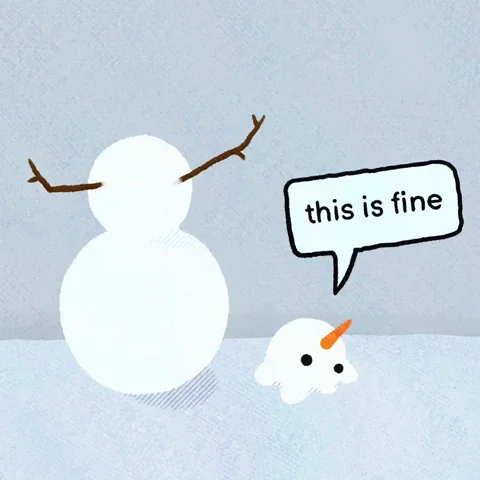Thoughts on ‘Hot Frosty’, Disability, & The Carceral System
Part two of my thoughts on Netflix's latest "funny" Hallmark-esque Christmas movie in which a snowman comes to life. On disability, police violence, and the carceral system.
Hello, friends.
Today I’m sharing PART 2 of my thoughts™️on the movie ‘Hot Frosty’, this time with a focus on disability, how it mirrors classic fairytale narrative prosthesis, and the carceral system. I know I left you with a bit of a cliffhanger at the end of my last post when I said that Jack, the hot not-so-frosty in question, dies in custody, but rest assured I’m going to be anything but succinct about it here.
Hot Frosty is in many ways a modern fairytale, not just in the sense that it’s now a part of a subgenre of Christmas fairytale romances, but also because it is inspired by the story of Frosty The Snowman. The premise is essentially, according to the writer Russel Hainline: “what if, when Frosty the Snowman came to life… he was a super-hot dude?”
And like many fairy tales [in western canon] it draws on disability as a means to add conflict to the story: Frosty may be made of “not-snow” now, but he has “severe heat intolerance”, sweats profusely, and literally dies as a result of being locked in a cell in a room that was too hot for him.
Jack is a fictional character whose ailment, whatever its medical designation or diagnosis might be in the real world, marks him as different, and the narrative constructs his difference as disability.
Note: Many people tend to think of ‘disability’ or ‘being disabled’ as being blind, deaf, or orthopedically impaired, but it also includes diseases (cancer and AIDS, to name a couple) and learning impairments such as dyslexia. I work with an inclusive understanding of disability, which includes impacts on managing domestic life, restrictions on participation in community and social life, mobility, activity limitation, etc. In this film, Jack has “extreme heat intolerance” which results in physical and cognitive decline, and as a result of being born yesterday, he displays what some people might view as an neurological or developmental disability.
I think Hot Frosty uses disability as “narrative prosthesis” (David Mitchell and Sharon Snyder)—that is, as a device of characterization, and or as a tool to create metaphor or create a narrative shift, and or presented as a contrast to ‘normalcy’. His nature as a Born Sexy Yesterday snowman with severe heat intolerance is somewhat prosthetic in so far as the story relies on elements of disability to further the plot and delineate his character.
In classic fairytale fashion, the movie doesn’t give us direct commentary on the impairment/disability from Jack, and instead only very briefly shows how Jack experiences the world (liking to eat ice; sweating and saying he’s hot; taking things extremely literally) and how nondisabled characters react to him (feeling that eating ice without a beverage is reason to suspect him; viewing his lack of fingerprints while he’s melting as evidence of some intense criminal history; taking advantage of his naivety).
Oftentimes when the hero in a fairytale has a disability, not only is their disability brought to the forefront of the story in a moment of triumph—the girl with no hands proves she is the king’s wife when she brings out her silver prosthetics, for example, or characters are rewarded with a magical cure and subsequent erasure of their differences—which is what happens to Jack in the end of the film when he becomes a real human.
But… how does he overcome his snowman limitations and become human?
Oh yeah. He dies.
In custody.
After being locked up by one of the only black characters, the sheriff who is obsessed with the law—and everyone knows it. It’s just a quirk. Don’t worry about it!

Personally, I feel some kind of way about the movie having a majority white cast, and then the only prominent man of colour is the “bad cop” Sheriff Nathaniel who is obsessed with upholding the law and incarcerating “bad” people to the point where someone dies in custody. It feels really strange to see this be the dynamic in a movie that is being played as a good time, when in real life, the people who are most likely to be victim to police violence are disabled people of colour.
In the last twelve months, I’ve been intentionally reading about abolition and disability justice, and was pretty uncomfortable watching a film that is objectively meant to be funny be run almost entirely on a bad-cop gag of incarceration, when horrible arrests, detentions, and deaths in custody really do happen way too often in real life, and to disabled folks especially—folks like Jack, whose medical needs are not met, and thus contribute to his death.
Jack is also functionally so naive that he willingly accepts arrest, believing it's fine and the right thing to do—because that's presumably, given the rest of the movie, what he's seen on TV—and it left me thinking… is this real? Am I actually seeing this right now?
While in custody, Jack is explicitly hot and struggling with his heat intolerance, but Sheriff Nathaniel ignores this while trying to take Jack’s fingerprints. Only, Jack is melting and his condition rapidly deteriorating, so he has none—and this is bodily difference only serves to further criminalise him/make him an object of further suspicion and danger, as manifestations and symptoms of disability often do in real life. Sheriff Nathaniel is utterly convinced that Jack must have burned off his fingerprints in order to live a life rife with terrible crime, and ignores both Jack and Kathy’s pleas for accommodating his health needs.
The majority of the most publicised victims of police violence are disabled, and I think US statistics estimate over 50% of people killed by police identify as disabled (as of 2024). Furthermore, the intersection between disabled and black/brown bodies in the carceral system and in police brutality cases is huge. Knowing all this, there was a kind of uncanny valley quality to Hot Frosty, to me, because it feels like the movie wants to be just a joke, but its contents rely on real and serious narratives of systemic harm that are anything but funny.
A pivotal, and indeed one of the most emotionally charged moments in the film, is when Kathy (the female lead) doesn’t have the full $2000 needed to pay Jack’s bail and get him out of custody to save his life, so the town’s people gather and collectively contribute as much money as they can. This is pretty much the only time the town comes out and actively contributes to helping Jack and going against the wishes of the law enforcement of the town—outside of this, several characters see the sherrif being power hungry and obsessed, and do nothing but comment on it.
But now, the sheriff counts the money, and says they’re still $10 short. He is then displeased with his son for donating the last $10, stating that “bad guys go to jail”, and only giving in when his kid challenges him.
But by then, it’s too late.
Jack is dead.
I was genuinely surprised to read the writer’s review on Letterboxd which says:
“yes, the movie’s got laughs, yes, it’s very silly, and yes, it’s got a very Hot Frosty... but I really, really tried to make the heart of the movie something that felt real to me. learning to love yourself, learning to find ways to move on… (and, as Vulture correctly pointed out, learning how to try to persevere in the face of police abuse of power!)”
🤔Hmm.
If you now me, you know that I’m not a fan of narratives that encourage perseverance while doing nothing to challenge the systems that demand it, and I feel like that’s what this movie does. While yes, Kathy and Jack try to keep him from being arrested, and in the end Kathy continues to try to get him out of jail, which is perseverance, I’m not sure exactly what was being learned. I’m not sure what lessons about police abuse of power the townspeople, or Jack and Kathy, took away from this experience.
Hot Frosty, to me, is less about learning how to try to persevere in the face of police abuse of power, and more about having a laugh and a cry at the expense of the most vulnerable member of a community—the police abuse of power in this movie is part of a gag until it leads to a death, at which point Kathy and the other gathered townsfolk just… turn around and begin to leave Jack’s body in the street. Sheriff Nathaniel is never held accountable for this death caused by his prejudice and negligence; instead, Jack’s death is treated as a sad but ultimately acceptable loss for which nobody faces any consequences.
Alas, it is fortunate that, just like in many fairytales, Jack is rewarded for his hardship and Kathy rewarded for her love, and he becomes a fully-fledged human being that, for the first time, feels the cold. And Jack is just the kind of naive character who would tell the sheriff that it’s all good, no harm was done, so I guess everyone lives happily ever after, afterall ✨
Anyway, that’s all from me on Hot Frosty.
Probably. What do you think?

